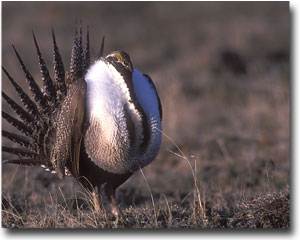The Sage Grouse (Centrocercus urophasianus) is the largest grouse in North America, where it is known as the Greater Sage-Grouse. Its range is sagebrush country in the western United States and southern Alberta and Saskatchewan, Canada. The greater sage-grouse is known for its elaborate courtship dance on the Prairies, but its enthusiastic display of virility might not be enough to save the endangered species from being wiped out in Alberta as soon as next year. A group of scientists hope to come up with ways to prevent the eventual extinction of the sage-grouse. Cliff Wallis from the Alberta Wilderness Association says the numbers have dropped to 30 in Alberta from the thousands 25 years ago. Wallis says the Alberta and federal governments are aware of the plight of the sage-grouse, but so far have failed to act. Cam Aldridge from Colorado State University says a similar decline of the species is occurring in the United States as well.
In their 1st week of life, sage-grouse chicks consume primarily insects, especially ants and beetles. Their diet then switches to forbs, with sagebrush gradually assuming primary importance. In a Utah study, forbs composed 54 to 60% of the summer diet of juvenile sage-grouse, while the diet of adult birds was 39 to 47% forbs.
A Wyoming study evaluated effects of eliminating insects from the diet of newly-hatched Sage Grouse chicks. All chicks hatched in captivity and not provided insects died between the ages of 4 and 10 days, whereas all chicks fed insects survived the 1st 10 days. Captive greater sage-grouse chicks required insects for survival until they were at least 3 weeks old. Greater sage-grouse chicks > 3 weeks old survived without insects, but their growth rates were lowered significantly, indicating insects were still required for normal growth after 3 weeks of age. As quantity of insects in the diet increased, survival and growth rates also increased up to 45 days, the length of the experiment.
In a study conducted in Idaho, Klebenow and Gray measured food items for juvenile greater sage grouse for each age class, classes being defined by weeks since birth. In the 1st week insects were very important – 52% of the total diet. Beetles, primarily family Scarabaeidae, were the main food item. Beetles were taken by all other age classes of chicks, but in smaller amounts. All ages fed upon ants and while the volume was generally low, ants were found in most of the crops. After week 3, insect volume dropped and stayed at a lower level throughout all the age classes, fluctuating but always under 25%.
Forbs were the major plant food of the chicks. Harkness gilia (Linanthus harknessii) was the main forb species in the 1st week and then steadily decreased. It was not found in the diet after 6 weeks. Loco (Arabis convallarius) and common dandelion were important food items for most of the collection period and occurred with generally high frequencies. Common dandelion was the most abundant food item and the mainstay of the sage grouse chicks. At 6 weeks of age, goatsbeard reached its peak in the diet and sego lily was found in greatest volume a week later. These 5 species were the most important forbs.
With plants like common dandelion and goatsbeard, all aboveground parts of the plant were sometimes eaten. The stems, however, were not of main importance. The reproductive parts, mainly buds, flowers, and capsules, were the only parts taken from some of the other species. Conversely, leaves were the only parts of sagebrush found in the crops. Leaves and flowers of the species listed above and other dicots contained higher amounts of crude protein, calcium, and phosphorus than sagebrush and may be important in greater sage-grouse diets for these reasons
Sources:
DAWN WALTON
CALGARY— Globe and Mail Update
Published Thursday, Sep. 01, 2011 8:17PM EDT
http://www.theglobeandmail.com/news/national/prairies/a-desperate-bid-t…
The Canadian Press, Wednesday Sep. 7, 2011 2:25 PM ET
http://www.ctv.ca/CTVNews/Canada/20110907/sage-grouse-demise-scientists…

- Log in to post comments
